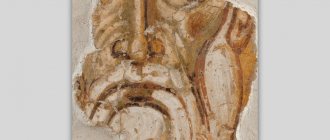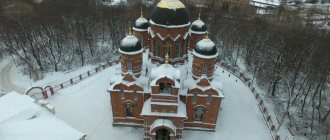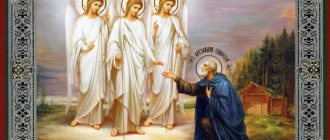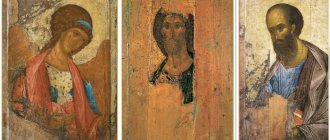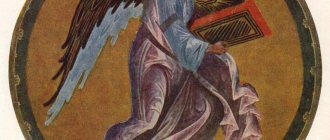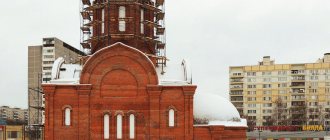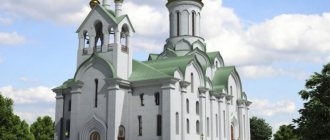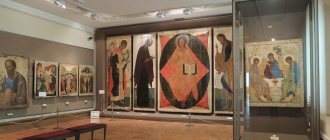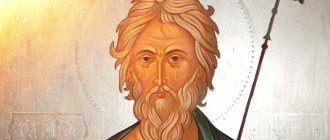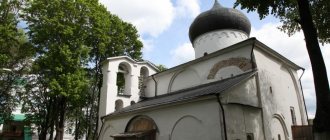“Secret” frescoes by Andrei Rublev in the Assumption Cathedral
In the competition for conservation and restoration work in the Assumption Cathedral in the city of Vladimir, at the beginning of December 2014, Vladimirrestavratsiya OJSC won. At the auction, Vladimir restorers beat out two rivals - LLC Restoration and Construction Enterprise of the Nativity of the Mother of God Monastery from Vladimir and LLC New Construction Technologies from Moscow. The work is scheduled for 2015-2016; the state plans to spend about 28 million rubles on the preservation of unique ancient frescoes, primarily those by the famous Andrei Rublev.
According to information from the Ministry of Culture of the Russian Federation, sent in response to a request from Zebra TV, the restoration will take place in three stages. In the first half of 2015, it is planned to work on Rublev’s frescoes above the choir, in the northern lunette and behind the iconostasis, as well as the oldest paintings from 1161 and 1189 in the northern gallery and behind the iconostasis. In the second half of this year, restorers will continue to work with paintings on pilasters and pylons behind the iconostasis, fragments of paintings from 1189 and 1237 in the southern gallery, frescoes by Rublev in the southern lunette, in the southern domed pylon, and in the altar. In 2021, specialists will begin painting Rublev under the choirs in the central nave and the southern small nave under the choirs.
In accordance with the restoration technology, the paint layer of the paintings will be strengthened, dirt, soot and mold will be removed, the painting will be treated with an antiseptic and covered with a protective layer, and the loss of the paint layer will be subjected to “tinting and suppression.”
The work will be based on the technology developed by Vladimirrestavratsiya for the restoration of monumental fresco and tempera paintings of 1161, 1189, 1237 and paintings of 1408 by Andrei Rublev. The Ministry of Culture reports that the restoration of the frescoes will take place exclusively “from top to bottom,” as the famous Vladimir restorer Alexander Skvortsov insisted. Only experienced and appropriately qualified specialists should be involved in the work.
About two weeks ago, scaffolding appeared in the cathedral. Specialists from JSC Vladimirrestavratsiya began preliminary work - removing dust from the iconostasis of the second half of the 18th century, which over many years had become covered with a decent layer of dirt and soot.
During this procedure, dismantling part of the altar ceiling near the tomb of Andrei Bogolyubsky, restorers uncovered fragmentarily preserved paintings of 1161, 1189 and 1408 by Andrei Rublev, which were covered by a baroque iconostasis from the time of Catherine II.
In the 20th century, researchers of the Assumption Cathedral guessed about the existence of “hidden” frescoes by Rublev, but these paintings were first seen during large-scale restoration work in 1975-1982. Then part of the iconostasis was dismantled, specialists from the Vladimir Scientific and Restoration Workshop saw these frescoes, and also discovered previously unknown images of two figures of prophets on the pilasters behind the iconostasis.
These “secret” paintings were restored at the end of the 1970s and again covered with an altar partition.
“During the current restoration, the frescoes on the northern pilaster were again opened from the iconostasis covering them, for which the icons were taken out, the carvings of the iconostasis were numbered and removed, and the skeleton of the iconostasis, which during the work of 1975-1982. was installed on special hangers and opened"
, - reports the Ministry of Culture in response to a request from Zebra TV.
The preservation of these paintings, little known outside the circles of restorers and art historians, is much better compared to the open frescoes of the Assumption Cathedral. However, they will also receive attention during the ongoing restoration.
In addition, according to the Ministry of Culture, after all restoration operations are completed, the issue of changing the contour of the iconostasis and opening the unique frescoes for public viewing can be resolved. Technologically, Vladimirrestavratsiya confirmed that such a possibility exists.
Currently, work on removing dust from the iconostasis and carefully photographing the paintings continues. Cartograms of the current state of the frescoes are compiled. In the near future, according to the Ministry of Culture, trial fortifications will be carried out. Only after specialists approve the results obtained will the planned work begin at the first stage of restoration.
The work is carried out under the strict control of the scientific and methodological Council of the Ministry of Culture. A working group has been created that will provide methodological support in carrying out the reconstruction.
Considering the complexity and uniqueness of the work, for this restoration the Ministry of Culture provided the maximum possible period for completing the work in accordance with existing legislation in the field of public procurement. Restoration of the frescoes of the Assumption Cathedral in the city of Vladimir must be completed before October 31, 2021. The phased work schedule developed by Vladimirrestavratsiya OJSC assumes that access of believers and tourists to the Assumption Cathedral will not be limited if possible. There are also no plans to cancel services.
Vladimir: since the 19th century. to the present day
The frescoes decorating the main cathedral of the Vladimir diocese were restored in 1882-84. For a long time they were almost all hidden under plaster and were opened during the construction of the cathedral only in 1882.
The honor of opening these frescoes belongs to His Eminence Theognostus, now Archbishop of Novgorod. Judging by the chronicles, the cathedral was decorated with paintings several times: both in 1161 and under Vsevolod III, and finally all the painting inside the cathedral was restored in 1408 by the famous icon painter Andrei Rublev; - experts in ancient Russian art and attribute most of the fresco images discovered in the cathedral to the beginning of the 15th century. In those places where the painting was not preserved, the frescoes were painted again according to sketches approved by the Imperial Moscow Archaeological Society and compiled in the image of the Staraya Ladoga and Spas-Nereditskys near Novgorod, preserved from the 12th century. To judge how well the restoration of the fresco painting was carried out, one should compare the frescoes on the walls with exact copies of fragments exposed from under the plaster, preserved in the choir of the cathedral in frames behind glass, the accuracy of which was certified by the construction commission.
The ancient frescoes under the choir and on the western wall, depicting the Last Judgment, are especially well preserved. On the western wall above the entrance arch, the artist depicted the preparation of the throne: on the throne is the Gospel, an eight-pointed cross with a cane and a spear; at the foot of the cross there is a vessel containing the blood of the crucified God-man, which washed away the sins of the human race; righteous scales are attached to the vessel, here Adam and Eve are in a kneeling position, as the perpetrators of human sin, whose guilt was redeemed by the crucified Savior. On the sides of the throne are the Mother of God and the Forerunner, begging the Lord for mercy on sinners; behind them is one angel with rods and with the seal of the living God (Apocalypse. XXI ch.) in their hands. The continuation of the picture on both sides consists of the apostles on thrones with open books, among whom the four evangelists are recognizable by the letters inscribed on the leaves of the books; mt lk mr iw, and angels in several rows with staffs. The idea of this image is that the apostles, as the closest producers of the human salvation given in Christ, will be accomplices in the Lord’s judgment over people. The central part of this image is Christ Himself, represented on the vault between the arches, seated in a circle formed of seraphim: the austere figure of the Savior, draped in a mantle, is represented at the decisive moment of the final judgment: with his right hand the Savior makes a gesture calling the righteous to the inheritance of the kingdom prepared for them heavenly, the left expresses the rejection of sinners. Next to the Savior are the sun, the moon and the stars, established in the sky, which has the shape of a linen twisted by two angels, in accordance with the words of the psalm: “all like a robe will wear out, and like a garment, you and I will change.”
Next to the image of the Savior, symbolic figures of the four kingdoms are presented inside the arch in a circle: Macdonian - in the form of a griffin, Roman - in the form of a winged dragon, Babylonian - in the form of a bear and Antichrist - in the form of a horned beast. This is the situation of the Last Judgment.
From here the artist moves on to depicting the trial process itself. He presented two angels, one of whom trumpets down, the other up, calling the living and the dead to judgment. By the sound of these trumpets, the earth and sea give up their dead. The earth is depicted here in the form of a woman with a staff in her right hand and a coffin in her left, around her there are resurrecting figures of people in white uniform bandages, and representatives of the kingdom of animals, birds and reptiles: a lion, an elephant, a pelican, a snake. Nearby is another ancient personification - the sea, also in the form of a woman with long flowing hair: with her right hand she holds an equipped ship, next to which sea fish swim.
By the sound of the same trumpets, the faces of the holy kings are raised, presented here in the costumes of the Old Testament righteous, and in caps, and one in a diadem; the faces of the holy martyrs in robes and tunics, the faces of St. saints in cross-shaped phelonions with short hair, faces of saints in lower garments tied with wide belts, mantles and one in a hood in the form of a cap; finally the faces of the holy women...
The judgment has taken place. It is followed by the bliss of the righteous and the torment of sinners. Ap. Peter, with the key in his right hand, leads the saints to heaven; in the distance Ap. Paul, in his left hand a scroll in which is written “Come with me good people,” with his right hand points to the place of bliss of the righteous. Caption: “The saints go to heaven.” There is a prudent thief with a cross in his left hand among the trees of paradise, with the inscription “the prudent thief is the light of the evening.” The very bliss of the righteous is presented in two forms: in one place the right hand is depicted, in which there are righteous souls: apparently the artist took literally the well-known biblical expression “the righteous souls are in the hand of God”; in another place he depicted Abraham's bosom: Abraham as an old man, Isaac as a mature man, and Jacob as a rather young man are sitting on a wide dais; Abraham has in his bosom the souls of the righteous in the form of children; next to him are several more childish figures, in halos and white shirts; all around is a paradise village. The picture of paradise is complemented by the image of the Mother of God on a throne among two angels, on the wall under the arch of the southwestern part of the temple. On the left side under the arch, the angel shows the prophet Daniel, who fell in front of him, to the fulfillment of his prophecy, pointing his hand to the righteous Judge.
Role in history
The Assumption Cathedral has seen many important historical events in its lifetime. It was here that Ivan IV was crowned king in 1547. Since Peter II, all Russian emperors have also been crowned here. The coronation of the imperial wife was also carried out separately - the empress knelt down, and her husband placed a smaller crown on her head. The exception was Elizaveta Alekseevna, the wife of Alexander I, who accepted the crown while standing. In 1613, the Zemsky Sobor was held in the temple building, at which Mikhail Fedorovich Romanov was elected tsar. Several important documents were also kept here, for example, the Act of Succession to the Throne, issued by Paul I, as well as the manifesto of Alexander I, according to which Nikolai Pavlovich could become emperor if Konstantin Pavlovich renounced the throne. In addition, some heads of the Russian Church were buried in the temple.
Icon painters
“The Legend of the Holy Icon Painters” of the 17th century reports that Andrei and Daniel carried out their icon painting works inseparably. Their friendship lasted for at least a quarter of a century. And they died almost simultaneously.
It is impossible to say definitely: this was written by Andrei, and here the hand of Daniel created. They didn't care about capturing their artistic personality. Perhaps the dissimilar temperaments - the more contemplative Andrei, the more expressive Daniil - allow us to outline the approximate features of a creative manner. Therefore, speaking about the icon painting of Andrei Rublev as the pinnacle of ancient Russian art, one must not undermine its foundation and tear Daniil out of Rublev’s creativity. We even have the right to ask ourselves the question: would Rublev’s genius have taken place without the addition of Daniil’s talent? Without his inspiring ideas, daily friendly communication, common prayers, mutual spiritual enrichment?
God knows.
Devotees
Information from sources about Andrei Rublev is scarce. He was first mentioned in the chronicle in 1405, when he painted the Annunciation Cathedral in Moscow under the direction of Theophanes the Greek. His last work was the painting of the Spassky Cathedral in his native Spaso-Andronikov Monastery around 1427.
The knowledge of sources about Daniel, who in the 17th century was mistakenly nicknamed the Black, is even more meager. In addition to the joint work with Andrei in Vladimir in 1408, he decorated the Trinity Cathedral of the Trinity-Sergius Monastery with frescoes and icons.
But this was enough to become a legend.
Neither the origin of the icon painters, nor their dates of birth, nor when they began working in Moscow, nor the time of their monastic tonsure, nor even where it happened - in the Spaso-Andronikov or in the Trinity-Sergius Monastery is known. Both appear in the chronicles already as monks, major craftsmen working for the Grand Duke. Daniel was obviously older, perhaps not only in years, but also in monastic experience. And when fate brought him together with Andrey, he became his teacher. Probably, at first it was spiritual guardianship over the new monk. But it is possible that Daniil was also Rublev’s artistic mentor for some time.
The “office” relationship very soon grew into a strong friendship - as far as one can even talk about friendship between monks. After all, emotional attachment to people for a monk is a burden, and sometimes an obstacle on the path of salvation. Rather, we need to talk not about friendship, but about brotherly spiritual love, which contained good comradeship and fellowship.
They “found” each other, dividing the monastic cell into two, worked together, fasted and prayed - until the end of their lives.
Construction of the cathedral
The first stone church on the site of the future Assumption Cathedral was founded in Moscow back in 1326 by order of the first Metropolitan of Moscow Peter and Prince Ivan Kalita. It is assumed that they decided to erect a stone building instead of a wooden church that had fallen into disrepair. It was then that Moscow received the important status of the capital city, and the new cathedral was to become the successor to the Assumption Cathedral in Vladimir. In the future main church of the state, a few months later its founder, Metropolitan Peter, was buried. In honor of the deceased, Ivan Kalita built a separate chapel in the cathedral for the Adoration of the chains of the Apostle Peter. A year after construction began, the cathedral was consecrated.
Reconstruction of the Assumption Cathedral under Ivan Kalita. (pinterest.com)
At the end of the 15th century, Ivan III decided to rebuild the cathedral. The temple was literally dismantled down to the last stone. Pskov craftsmen were invited to work on the new building, but the temple, according to legend, unexpectedly collapsed. Then Ivan Vasilyevich chose a new candidate for the architect - the Grand Duke liked the Italian architect Aristotle Fioravanti. The new temple was built according to the model of the Vladimir one. Construction took five years, and in 1479 the Assumption Cathedral was consecrated.

